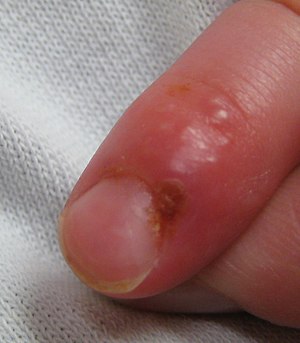Whitlow
Top Contributors - Kehinde Fatola, Joao Costa, Shaimaa Eldib and Temitope Olowoyeye
Introduction[edit | edit source]
Whitlow is a very painful and infectious viral disease of the thumb and fingertips. Rarely, it infects the toes and nail cuticle. [1] It is a self-limiting disease and it is of two types - Herpetic Whitlow and Melanotic Whitlow. Herpetic whitlow is more prevalent of the two. It is a disease of the hand.
Mechanism of Injury / Pathological Process[edit | edit source]
Herpetic whitlow is caused by the Herpetic Simplex Virus (HSV). HSV is of two types - type 1 and type 2. [2] They are both known to cause whitlow. Herpetic whitlow is caused when a wounded and exposed skin comes in contact with body fluids contaminated with HSV. It may also be caused by bacterial fingertip infection. [3]
Risk factors include;
- Human Immunodeficiency Virus (HIV) infection
- Nail biting habit
- Wounded finger with exposed skin surface
- Career in health care profession
Clinical Presentation[edit | edit source]
The finger may present with; [4]
- Tingling
- Itchy feeling
- Burning sensation
- Blisters
- Redness, warmth or swelling
The body may present generally with; [4]
- Fever
- Lymphangitis
- Blisters and sores on other parts of the body
- Enlarged lymph nodes in the arm
High fever (temperature over 101°F) and confusion/lack of consciousness may indicate serious infection/progression of the disease.
Management / Interventions[edit | edit source]
Although, there is no known cure of the disease and the disease is a self-limiting one, therefore, it usually resolve within two to three weeks. However, certain measures may be undertaken to improve the symptoms. These include; [4][5]
- Topical anaesthetics to reduce pain and itching
- Antiviral medications
- Analgesics to reduce pain and fever (if present)
- Electrotherapy
Not much research work has been done on Physiotherapy and Whitlow.
Complications[edit | edit source]
Untreated whitlow can come with serious complications which include; [4]
- Encephalitis
- Meningitis
- Tenosynovitis
- Pain and discomfort
- Spread of infection
- Skin ulcerations and infections
References[edit | edit source]
- ↑ Clark DC. Common acute hand infections. American Family Physician. 2003;68 (11):2167–76.
- ↑ Wu IB, Schwartz RA. Herpetic Whitlow. Cutis. 2007;79(3): 193–6.
- ↑ Hoff NP, Gerber PA. "Herpetic whitlow". Canadian Medical Association Jouurnal. 2012;184: E924
- ↑ 4.0 4.1 4.2 4.3 Lloyd WC. Whitlow. Available from; https://www.healthgrades.com/right-care/infections-and-contagious-diseases/whitlow (Accessed 19/Oct/2020)
- ↑ Ismailov TA, Yevdulov OV, Khazamova MA, Gidurimova DA. Experimental Investigations of Thermoelectric Device for the Therapy of Whitlow. Journal of Thermoelectricity. 2013;4:78-84







